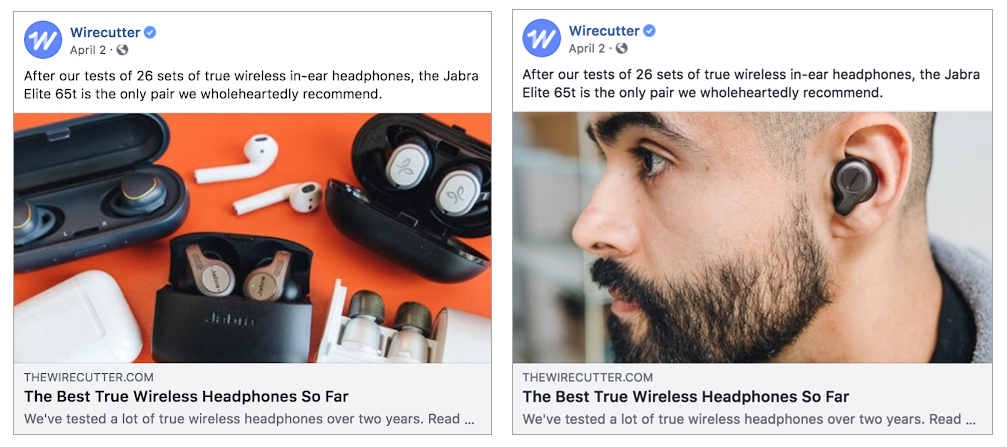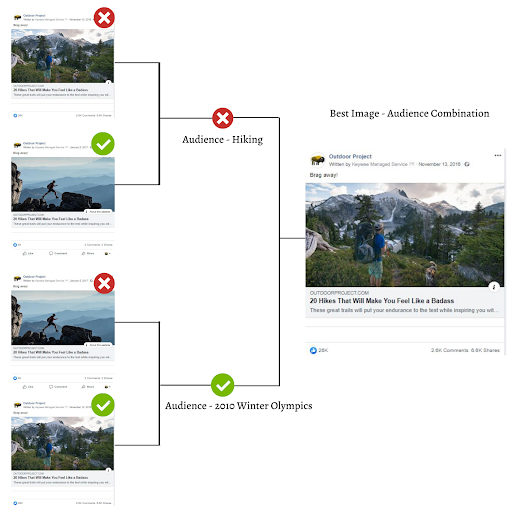The reason social media is such a strong marketing tool, apart from the massive reach it offers, is the versatility of ads that marketers can create to engage with their audiences. And while there are thousands upon thousands of articles filled with tips and best practices, the simple truth is that there is no silver bullet, there is no best way to reach your audience, and actual results will ultimately vary.
So, how do you decide what to post? How can you make sure that you’re getting the best performance out of your social media ads? The most commonly used method is to run small-scale controlled tests — A/B tests — to gain those insights efficiently.
What is A/B Testing?
In the context of marketing campaigns on social media, A/B testing is the process of running versions of ads that are different from one another in only one aspect. While it may seem simple enough, the sheer amount of ad variations that are possible requires you to be very precise and to plan your split tests in advance. Otherwise, you might end up with no significant insights and a budget that was wasted, not invested.
If you’re wondering, “Do I need to test every ad variation against all of the others?” the answer is no. Think of A/B testing like the playoffs: One team wins despite only playing against some of the teams, not all of them. When running an A/B test, it’s crucial to only test one variable at a time, then after you test different images or other variables, you can pit the winners of the different tests against each other to find the best ad.
What can you expect to get back from the test? In a word: insights. With A/B testing, you can gain insights into what micro-content, or post, works better. More specifically, learn what types of imagery, post texts, headlines, Calls To Action (CTA), and other aspects of your campaigns work better for your audience on social media. For content marketers specifically, A/B testing has another critical dimension: It can help them decide which content drives the most loyal audiences and delivers the best results.
Keep in mind though, A/B testing is a never-ending process. What worked today may not work in a month, so you will have to continue your tests and test different variables on occasion.
Types of Social Media Testing: What Variables Should You Test?
- Layout / Ad Format: When creating the ads that you’ll test, you should think of which format makes sense to run given your goal. Are you going to try a carousel ad, a link ad, or a video ad? While some seem counter-intuitive given the campaign that you’re working on, they might still be worth a try. For example, we found that video ads generated CTRs that were 2X higher than link ads for some customers. Testing different layouts would be one of the first things you would want to test, as they are the foundation of future split tests.
- Visuals: Does the dominant color make a difference in performance? Should the visual include people? Does it affect the conversion rate down the funnel? The answers can change dramatically based on a campaign’s goal. Below are the results of an experiment that we ran with Wirecutter, testing different images of products with vibrant background colors against images of people using the products. The unusual result caught us by surprise: Although photos that include people typically perform well on social media, for Wirecutter, the product shots worked better.
The creative on the left performed 75% better than the creative on the right.
- Text: You can try testing your headline, post text, and description to see which has the biggest effect. Here are a few examples of what you can test:
- Play around with Emojis – Do they work for you? Which ones produce better results?
- Text length – For some, short and simple is best. For others, very long post texts work better.
- Hashtags – Do they affect your CTR in any way? Or would your audience find them off-putting?
- Numbers – Is your audience more likely to click when the headline contains a number, e.g. “8 Great Recipes for Anyone on a Budget”?
- Audience: Test your assumptions about who your target audience is. Does the persona imagined at that marketing meeting match the results that you see? For example, when we first began working with a fashion startup using content to generate sales, the belief was that its core audience was younger women between the ages of 20 and 35. However, we found that while the startup had a high CTR and a low CPC, the best engagement with social media ads and return on ad spend (ROAS) came from women over 35. This difference was so notable that it affected the company’s content strategy as a whole, and the team quickly began writing articles to cater to these newfound shoppers.
- Placement: One of the major advantages of working with Facebook’s ad platform — on top of the granular targeting capabilities — is the ad placements you can access which include other social media platforms such as Instagram, Messenger, and Facebook’s Audience Network. You can let Facebook optimize the ad placement with the automatic placements feature, and compare the results against the hand-picked placements where you think your audiences would engage.
- Content: Content marketing has become the backbone of many digital marketing strategies. As such, a lot of companies dedicate resources to content creation, making the content itself worthy of split testing. Is a specific section on your site driving more engaged users than others? Are people more predisposed to take action if they start their journey in one section than another? If you’re creating content, testing different pieces has to be part of your overall A/B testing strategy, as it will supply you with valuable insights.
Getting Down to Business: How to Test
Step One: Decide on your goals
Knowing what your objectives are is fundamental to setting up a campaign that will yield the best results. Identifying your objectives correctly will help you both in planning your budget and in deciding what to test. Is your goal to achieve a high CTR? Low CPAs? Overall impressions? The possibilities on various social media platforms are endless, so it’s important you define what success means to you.
Step Two: Decide what to test
Based on your goals, you’ll be able to decide how many factors you can test initially, or how many iteration cycles you can run to find the best ad. For example, when optimizing for overall impressions, your aim would be to get the lowest Cost Per Thousand Impressions (CPM). The main elements that affect the CPM are the ad placement and targeted audience, so that is what you’d start testing. If you’re optimizing for high CTR, on the other hand, the creative assets (the copy and visuals that comprise the ad) and CTAa also have a strong impact. Your goals will guide you in the process of choosing which factors of the ad make sense to test.
Step Three: Set your budget
Once you know the goal that you’re optimizing around, it’s time to plan your budget. How much money are you willing to put into a test? Some considerations: Where in the marketing funnel is the goal located? Are there specific hypotheses you need to examine? For example, if you have a target CPA of $8, you can use that as your benchmark. According to Facebook, you need a minimum of 50 conversions per week for its optimization algorithm to perform well. Doing the math ($8 CPA x 50 conversions) gives you a test budget of $400. You should add some wiggle room for ads that will underperform, so a final test budget of around $450 would likely be sufficient.
Step Four: Run your test
Below is an example of a test we ran here at Keywee. The objective was to optimize an audience development campaign for loyal visitors with clicks coming in under a specified price. With only a small budget for testing, we decided to start the experiment with which type of image (either focusing on the person or on the landscape) would drive higher engagement rates. We also tested two different audiences, as people react to ads differently. When the test concluded, the winning ad had a CPC that was lower than the next best ad by 50%.
Step Five: Repeat
Once you finish your test, take the best performing ad and scale your spending on it to achieve your goal. Then, make a change to one aspect of it that you haven’t tested yet, and run another experiment to examine its effect on performance.
You Finished Your A/B Test, Now What?
Well, the good news is that you now know what is likely to work and move the needle for your digital marketing campaigns. You have the data to back up your claims and you can share it with colleagues. Whether your aim is to get paid subscriptions, beef up your email database, get eyeballs on branded content pieces, or anything else, you now know what is more likely to work for you.
The bad news is that, just like shampoo, for the best results you should rinse and repeat. Not only are there other variables to test, but as time passes and algorithms change, you will need to test your results again to make sure they still hold.
As you scale your campaigns to meet your KPIs, make sure to set aside some budget to continuously test more content, more ad components, or different social media platforms altogether.
Final Takeaway
Continuous testing ought to be a key part of every social media advertising campaign. Whether you’re a brand or a publisher, only with efficient testing will you improve your results.
Our rule of thumb is to dedicate up to 10% of a campaign’s budget for testing. This split allows you to meet your KPIs with the remaining 90%.
At Keywee, we help storytellers supercharge their A/B testing. If you’d like to hear more about how we can work together to help you, let us know.



